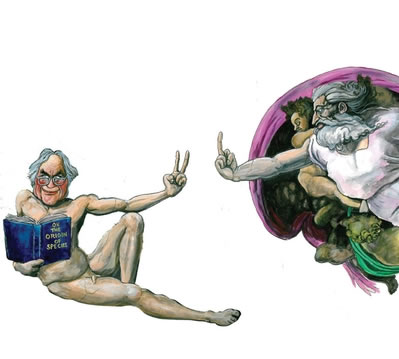For me, being a humanist means believing that, while we were not dropped from the sky by a separate act of creation, we are profoundly different from all other living creatures. We are people as well as organisms and lead our lives in a way unknown to other living creatures that merely live their lives. I accept what Darwinism tells us about the origin of the species H.sapiens but I don’t think it follows from this that we are pieces of nature in the way that ants, flamingos and chimpanzees are pieces of nature.
 Human difference is evident in the manner in which we blow our noses as well as in more obviously sophisticated activities such as making symphonies, poems and cathedrals. Which is why I have devoted an entire book – Michelangelo’s Finger: An Exploration of Everyday Transcendence – to the seemingly insignificant gesture of pointing. Pointing is a human universal and it is unique to humans. Thinking about what it requires, and what it leads to, is a reminder of other things that are unique about man, the only creature that points things out to his conspecifics.
Human difference is evident in the manner in which we blow our noses as well as in more obviously sophisticated activities such as making symphonies, poems and cathedrals. Which is why I have devoted an entire book – Michelangelo’s Finger: An Exploration of Everyday Transcendence – to the seemingly insignificant gesture of pointing. Pointing is a human universal and it is unique to humans. Thinking about what it requires, and what it leads to, is a reminder of other things that are unique about man, the only creature that points things out to his conspecifics.
To point something out to others, in the usual manner, requires a certain amount of kit – an arm, a hand, an index finger that has a good deal of independence of movement, and the ability to direct them to a target and keep them steady. In addition to this essentially biological kit, much else beside is needed – what we might call “metaphysical” kit – and it is this that makes pointing an interesting marker of our distance from animals. You have to have a sense of your body as an instrument that transmits signs; this requires that you are not just an organism but an embodied subject. If you are not persuaded that this is necessary, remember that, in addition, pointing humans have to conceive of their bodies as the source of signs being interpreted (following the rather complex rules that pointing has and which no animal understands) by another human being. When you point, you solicit joint visual attention to something which potentially could be shared. In doing so, you have to put yourself in my shoes – seeing what it is I cannot see – and expect me to put myself in your shoes, by assuming the viewpoint from which you’re pointing.
That’s quite a lot and it draws on much of what is unique in us: we have a sustained sense of self (and of our viewpoint as a viewpoint) and of other as selves (that have different viewpoints). The role of pointing as a precursor of language (appearing just a few months before the first word) and as an important device by which a child assists itself, and gets others to assist it, in acquiring language, is no accident: it is rooted in the same kind of consciousness that makes human language possible. When a child fails to point, as happens in autism, this is a sign of profound problems, in particular relating to the development of socialisation, imagination and language.
When I point to something that you cannot yet see, I make you aware of an object that seems to exist but has only general properties and does not have a definite relationship to your body. Pointing thereby opens up a distinctly human world of possibility located in a space that is distinct from the physical space of nature and of the organism. Although we are rooted as organisms in the material world of actual things, our human lives – which are the lives of persons as well as the career of bodies – are located in a boundless sphere of possibility, only some of which will be realised. Our distinctive freedom arises from the fact that we operate upon the actual world from this fabulously rich “virtual outside” composed of possibility. Pointing helps to construct the first floor of this many-storied realm.
As might be expected of any human sign, it is subject to endless transformation. In Michelangelo’s Finger I talk about the way the pointing index finger becomes an instrument of nagging, aggression, assertion and other things that feature in the power play of everyday life. I also look at the mystery of pointers that are separated from the human body – such as signposts, which enable Anyone and Everyone to point for the benefit of Anyone and Everyone. Such signs underline the community of minds to which humans belong. That community of minds lies at the basis of the human sense of a Great Self, usually known as God, that some suppose to underpin the meaning and intelligibility of the world.
Pointing consequently not only is a manifestation of the everyday transcendence of ordinary life but also has a part in building the world picture which is, historically, regarded as transcendent in the more highfalutin sense. Man The Pointing Animal imagines a divine gaze, a divine finger that points at himself. When Michelangelo drew that famous image of The Creation of Adam on the ceiling of the Sistine Chapel he perhaps knew more than he realised.
Michaelangelo’s Finger: An Exploration of Everyday Transcendence is published by Atlantic

